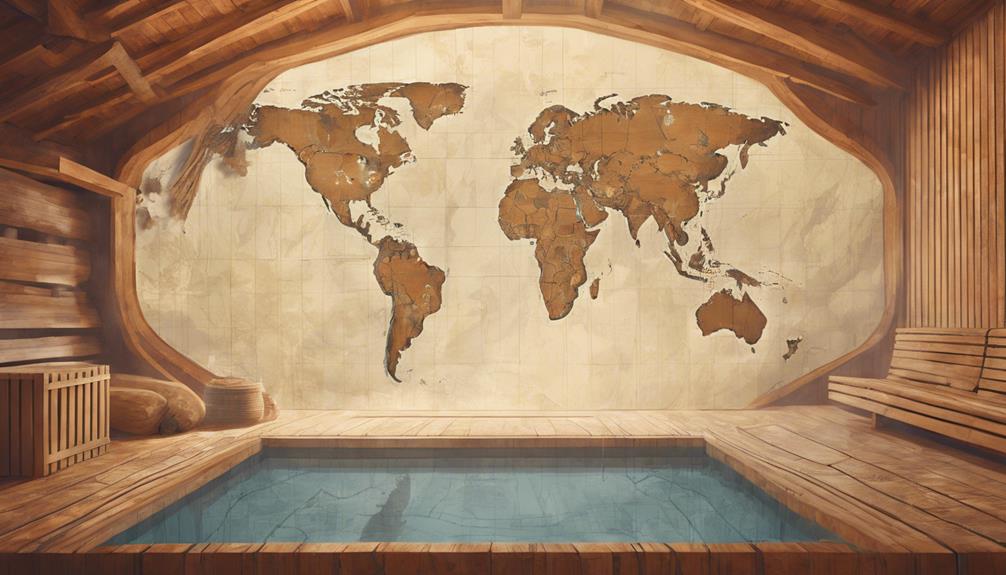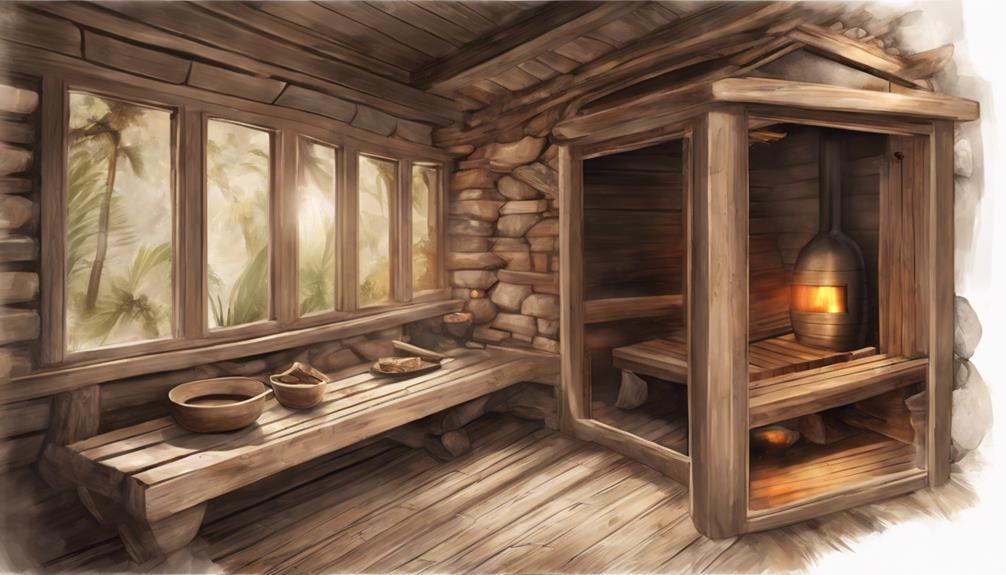Seven Tips to Understand Sauna Culture's Historical Evolution
Did you know that sauna culture has a rich and fascinating historical evolution? It's not just about sitting in a hot room and sweating; there is so much more to it.
From the ancient origins of saunas to the global expansion of sauna culture, there are seven key tips that can help us understand how saunas have evolved over time.
By exploring these tips, we can uncover the technological advancements, cultural influences, and societal significance that have shaped sauna culture into what it is today.
So, let's dive into this intriguing journey and uncover the secrets behind the sauna's historical evolution.
Key Takeaways
- Sauna culture originated in Finland and has spread globally, influencing sauna practices worldwide.
- Sauna technology has evolved from wood-burning stoves to modern electric heating systems, improving comfort and efficiency.
- Sauna culture promotes wellness, relaxation, and social bonding, with saunas offering therapeutic benefits and serving as spaces for communal gatherings.
- Sauna architecture, design, etiquette, and customs all contribute to creating a relaxing and rejuvenating sauna environment.
Ancient Origins: The Birth of Sauna Culture
Ancient Origins: The Birth of Sauna Culture can be traced back over 2,000 years, with evidence of early saunas discovered in Finland. Finnish saunas, with their steam and heat, have been a central aspect of sauna culture and have played an integral role in the lives of the Finnish people. In ancient times, these saunas weren't just places for bathing, but also for purification rituals and social gatherings. They were seen as sacred spaces, where individuals could cleanse themselves physically and spiritually.
The historical evolution of sauna culture in Finnish society is fascinating. From simple pits dug into the ground, saunas developed into more sophisticated above-ground buildings with chimneys and wood-fired stoves. This evolution reflects the importance of saunas for the physical and mental well-being of the Finnish people. Saunas became a place where people could relax, unwind, and connect with others. They provided a sanctuary from the stresses of daily life, promoting both physical and mental rejuvenation.
Finnish Influence: Spreading the Sauna Tradition

The far-reaching influence of Finnish sauna culture has led to the widespread adoption and appreciation of the sauna tradition around the world. The Finnish influence on sauna culture has had a profound impact on the development and spread of sauna practices and traditions globally. Here are four key ways in which Finnish sauna culture has spread:
- Finnish sauna design: The Finns revolutionized sauna design by introducing wood-burning stoves and chimney vents, ensuring proper heating and ventilation. Their innovative designs have been embraced worldwide, shaping the modern sauna experience.
- Communal bathing: Finnish sauna culture placed a strong emphasis on communal bathing, transforming saunas from a necessity for hygiene to a social and cultural tradition. This communal aspect has been adopted in saunas across the globe, creating a sense of community and shared experience.
- Sauna traditions: Finnish sauna practices, such as alternating between hot sauna sessions and cold plunges, have become widely adopted as part of sauna traditions worldwide. These practices not only promote relaxation but also have potential health benefits.
- Global impact: The Finnish sauna culture's global impact can't be overstated. It has inspired the development and appreciation of sauna traditions in various countries, contributing to the rich tapestry of sauna history and cultural tradition.
The Finnish influence on sauna culture has been instrumental in spreading the sauna tradition, shaping its design, fostering communal bathing, and establishing sauna practices and traditions around the world.
Global Expansion: Sauna Culture Across Continents

Sauna culture's global expansion has led to the adoption and adaptation of traditional practices across continents, showcasing the diverse variations in sauna design, rituals, and social norms. Sauna traditions have spread to countries such as Finland, Turkey, Native American communities, and Japan, each adding its own unique flair to the sauna experience. This global sauna community reflects the universal appeal and adaptability of sauna traditions worldwide.
As sauna culture has expanded, it has influenced wellness practices and promoted relaxation and social bonding. The sauna's therapeutic benefits have been embraced by people around the world, who use it as a means of detoxification, stress relief, and rejuvenation. The sauna's heat and steam have a calming effect on the body and mind, providing a sanctuary for self-care and reflection.
Cultural adaptations have played a significant role in the global expansion of sauna culture. Different continents have incorporated their own customs, materials, and design elements into the sauna experience. For example, Finnish saunas often use wood-burning stoves, while Turkish hammams feature marble interiors and steam baths. These adaptations highlight the rich diversity of sauna traditions and contribute to the global appeal of this wellness practice.
Evolution of Sauna Technology: From Fire to Electric

With the advent of modern technology, the evolution of sauna heating methods has witnessed a significant transition from fire-based systems to the convenience and efficiency of electric heating. This shift in sauna technology has brought about numerous advancements and improvements, revolutionizing the traditional Finnish sauna experience.
To paint a picture of this evolution, here are four key developments in sauna technology:
- Introduction of electric saunas by John Harvey Kellogg: In 1893, Kellogg introduced electric saunas, marking a milestone in sauna technology. This innovation replaced the need for fire-based heating, making saunas more accessible and easier to control.
- Focus on energy efficiency: As technology progressed, engineers began emphasizing energy efficiency in sauna design. Electric saunas efficiently convert electricity into heat, reducing energy consumption and making them more environmentally friendly.
- Enhancing the overall sauna experience: Modern sauna technology has also focused on improving the user experience. From adjustable temperature controls to automatic timers and customizable features, electric saunas offer a more personalized and enjoyable sauna session.
- Infrared saunas for therapeutic benefits: In recent years, infrared saunas have gained popularity for their therapeutic benefits. These saunas utilize heat-conductive light bulbs to generate infrared heat, which is believed to promote relaxation, detoxification, and pain relief.
Through the evolution of sauna technology, the shift from fire-based heating to electric systems hasn't only improved energy efficiency but also enhanced the overall sauna experience, providing users with a more convenient and therapeutic sauna session.
Sauna as a Cultural Phenomenon: Healing and Relaxation

After exploring the evolution of sauna technology and its advancements, it's fascinating to delve into the cultural phenomenon surrounding saunas and their profound healing and relaxation benefits. Saunas have been recognized for centuries as a powerful tool in promoting physical and mental well-being. The therapeutic effects of heat in saunas are renowned for their ability to induce sweating and detoxification, allowing the body to release toxins and rejuvenate itself. This process not only cleanses the body but also relaxes the mind, promoting a sense of calm and tranquility.
Sauna culture has evolved to incorporate various rituals that enhance the overall experience. From social bonding to spiritual reflection, sauna rituals have become an integral part of sauna culture. They provide opportunities for individuals to connect with others, share stories, and form deeper connections. Moreover, saunas offer a space for individuals to reconnect with nature, allowing them to find solace and inner peace.
The appeal of sauna culture extends globally, transcending cultural boundaries. Saunas have become a universal symbol of relaxation, rejuvenation, and overall wellness. Their ability to promote physical and mental well-being has made them popular in various communities and cultures worldwide. Whether it's the Finnish tradition of sauna or the Japanese practice of onsen, saunas have a universal appeal that speaks to the need for healing and relaxation in our fast-paced modern lives.
Frequently Asked Questions
What Is the History of the Sauna?
The history of the sauna is fascinating. It has ancient origins and has been utilized in various cultures, from Roman bathhouses to Native American sweat lodges. Sauna traditions in Finland and Scandinavian countries are particularly noteworthy. The sauna has played a role in religious ceremonies and is known for its therapeutic benefits. In modern culture, it has gained popularity, influencing architecture, design, and mental and physical health.
What Is the Sauna Culture?
Sauna culture is a fascinating blend of health benefits, ritual practices, social gatherings, and therapeutic effects. It encompasses traditional customs, cultural significance, relaxation techniques, sauna etiquette, and the healing properties of sweat therapy.
How Does the Cultural Tradition of the Sauna Support Wellbeing?
The cultural tradition of the sauna supports my wellbeing in various ways. It provides health benefits like relaxation techniques, social bonding, mental rejuvenation, detoxification process, skin purification, stress relief, immune system boost, improved cardiovascular health, and pain and muscle relief.
What Was Smoke Used for in the Sauna in the Past?
In the past, smoke was used in the sauna for various purposes. It played a crucial role in traditional sauna practices, providing heat and creating a purifying atmosphere. Ancient sauna traditions relied on smoke as a therapeutic element, contributing to the evolution of sauna culture.
Conclusion
In conclusion, the historical evolution of sauna culture is nothing short of a transformative journey that has left an indelible mark on societies worldwide.
From its humble beginnings in ancient man-made caves to its global expansion and adoption of modern technology, the sauna has become a cultural phenomenon that goes beyond mere relaxation.
It's a testament to the power of human ingenuity, the importance of tradition, and the universal desire for healing and connection. The sauna truly stands as a beacon of well-being and communal bonding throughout history.







